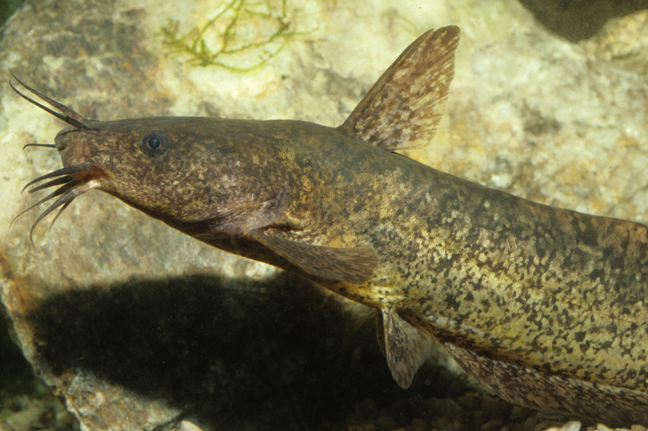Freshwater Cobbler, Tandanus bostocki Whitley 1944

Freshwater Cobbler, Tandanus bostocki. Source: Gerald R. Allen / Western Australian Museum. License: All rights reserved
A large mottled brown catfish endemic to south-western Australia. The Freshwater Cobbler has an eel-like body with continuous second dorsal, anal and caudal fins, and 4 pairs of barbels surrounding the mouth. The dorsal and pectoral fins are armed with venomous spines that may inflict a very painful sting.
YouTube video of Freshwater Cobbler by the Freshwater Fish Group of Murdoch University.
Freshwater Cobbler, Tandanus bostocki Whitley 1944
More Info
|
Distribution |
Endemic to temperate waters of southwestern Western Australia, from Frankland River (35°S) to Moore River (31°25’S). Although usually found in freshwater, this species is tolerant of brackish conditions. Freshwater Catfish are nocturnally active and inhabit slow-moving streams, isolated pools in river beds, reservoirs and some freshwater lakes. Individuals swim close to rocky, sand or gravel bottoms and may shelter in river bank holes and amongst the submerged root mounds of sedge tussocks. |
|
Features |
First Dorsal fin I, 6 or fewer; 2nd Dorsal + caudal + anal fin rays 150; Gill rakers 16-21. Body elongate, slender, laterally compressed and tapering posteriorly; tail pointed; head broad and flattened; four pairs of barbels around the mouth, 2 pairs below the upper lip and 2 pairs above; lateral line present. Scales absent, body covered in smooth skin. First dorsal fin small, moderately elevated with a sharp spine and 6 or fewer soft rays; 2nd dorsal and anal fins confluent with caudal fin, originating on middle of back; caudodorsal fin base about 50% SL; pectoral fin with sharp spine on outer edge. |
|
Size |
Maximum size to 50 cm , commonly to 25 cm. |
|
Colour |
Brown to tan (darker on head and back) with distinctive mottling on head, body and fins. |
|
Feeding |
Carnivore - feeds mostly on freshwater crayfish, shrimps and small fishes. |
|
Biology |
Spawning occurs during spring and summer, and individuals migrate upstream to spawn. Males make a nest of gravel and rocks with a central sandy depression into which females deposit spherical and non-adhesive eggs that hatch in around 7 days. Individuals may live for up to 10 years. |
|
Remarks |
Undertakes mass upstream migrations at night to feed and for spawning, returning to shelter under the same logs during the day. |
|
Species Citation |
Tandanus bostocki Whitley 1944, Aust. Zool. 10(3): 252-273. Type locality: Serpentine, WA. |
|
Author |
Gomon, M.F. & Bray, D.J. 2016 |
Freshwater Cobbler, Tandanus bostocki Whitley 1944
References
Allen, G.R. 1982. Inland Fishes of Western Australia. Perth : Western Australian Museum 86 pp. 6 figs 20 pls.
Allen, G.R. 1989. Freshwater Fishes of Australia. Neptune, New Jersey : T.F.H. Publications 240 pp., 63 pls.
Allen, G.R., Midgley, S.H. & Allen, M. 2002. Field Guide to the Freshwater Fishes of Australia. Perth : Western Australian Museum 394 pp.
Beatty, S.J., Morgan, D.L., McAleer, F.J. & Ramsay, A.R. 2010. Groundwater contribution to baseflow maintains habitat connectivity for Tandanus bostocki (Teleostei: Plotosidae) in a south-western Australian river. Ecology of Freshwater Fish 19(4): 595-608.
Castelnau, F.L. de 1873. Contribution to the ichthyology of Australia. 8. Fishes of Western Australia. Proceedings of the Zoological and Acclimatisation Society of Victoria 2: 123-149.
Hobbs, R. P. & Hassan, M. 2010. Pseudocapillaria (Ichthyocapillaria) nannupensis n. sp. (Nematoda: Capillariidae) from the intestine of the freshwater cobbler Tandanus bostocki (Plotosidae) from south-western Australia. Comparative Parasitology 77(1): 20-24.
Hoese, D.F. & Gates, J.E. 2006. Plotosidae. pp. 357-365 in Beesley, P.L. & Wells, A. (eds). Zoological Catalogue of Australia. Volume 35 Australia : ABRS & CSIRO Publishing Parts 1-3 2178 pp.
Hutchins, J.B. 2001. Checklist of the fishes of Western Australia. Records of the Western Australian Museum, Supplement 63: 9-50
Lake, J.S. 1978. Australian Freshwater Fishes. Melbourne : Thomas Nelson 160 pp. 140 figs.
Merrick, J.R. & Schmida, G.E. 1984. Australian Freshwater Fishes Biology and Management. Sydney : J.R. Merrick 409 pp. figs 280 col. figs.
Morgan, D.L., Gill, H.S. & Potter, I.C. 1998. Distribution, identification and biology of freshwater fishes in south-western Australia. Records of the Western Australian Museum, Supplement 56: 1-97.
Morrison, P.F. 1988. Reproductive biology of two species of plotosid catfish, Tandanus bostocki and Cnidoglanis macrocephalus, from south-western Australia. Ph.D Thesis, University of Western Australia, 187 pp.
Musyl, M.K. & Keenan, C.P. 1996. Cryptic speciation and low genetic variability in Australian freshwater eel-tailed catfish Tandanus tandanus Mitchell (1838) (Teleostei: Plotosidae). Copeia 1996(3): 526–534
Unmack, P.J. 2001. Biogeography of Australian freshwater fishes. Journal of Biogeography 28: 1053-1089
Welsh, S.A., Jerry, D.R. & Burrows, D.W. 2014. A New Species of freshwater eel-tailed catfish of the genus Tandanus (Teleostei: Plotosidae) from the wet tropics region of eastern Australia. Copeia 2014(1): 136–142. http://dx.doi.org/10.1643/CI-13-067.
Whitley, G.P. 1944. New sharks and fishes from Western Australia. The Australian Zoologist 10(3): 252-273 figs 1-6

